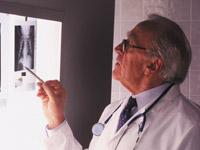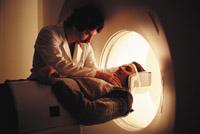Math Assistant
Johann Radon (1887-1956) and mathematical idea
Johann Radon was born in 1887 in Tetschen (Bohemia), currently Decin, Czech Republic. He studied mathematics at the University of Vienna and, after teaching at several German universities, returned to Vienna in 1947, where he died as a professor in 1956. He is known by mathematicians, who abandoned important works, especially in integration theory.
Although not so well known, the result behind the tomography is in Radon, preceded by a 1917 article. In technical terms, a version of Radon's beautiful theorem could be expressed as: a given function on the plane can be recovered by integrals (one-dimensional) performed on all straights. And knowing these integrals, he also gave a formula to recover the function. Without further frightening the reader who feels lost among these mathematical terms, we will see a simple example.
Suppose in the plane we have a closed set with two holes inside, as the picture shows. Being off the plane and looking unhindered, as you do when reading this page, you have no trouble seeing the inner holes. But the ant that lives on paper and cannot lift the head of the paper can only describe the outer boundary that surrounds the whole. How will you know that inside there are two holes? In the same way, if there was a wall on the outer boundary of the set, our eyes could not see the inner part and we would be in the same state of the ant, knowing the edge, but without any information of the interior. What is Radon's theorem? "If you give me the length that each straight line gives when cutting the set, I'm going to completely define the set," Radon tells us, as it allows to describe all the outer and inner limits. (Taking on the set a function worth 1 and out and 0 in the holes, the integral on a straight line is the indicated length.) We have modified the problem, now we would need cutting lengths, but it seems that to calculate the lengths we have to know the inside. Are we on a crazy wheel?
Allan Cormack (1924-1998) and the theoretical solution
Allan Cormack was born in Johannesburg, South Africa, in 1924, son of Scottish officials. He began his engineering studies at the University of Cape Town, but eventually decided to switch to physics. During his doctoral thesis at the prestigious Cavendish Laboratory in Cambridge, he studied a university offer and returned to South Africa before completing the thesis. Years later he moved to Harvard University to conduct research and eventually stayed in the United States as a professor and researcher at Tufts University (Massachusetts).
According to him, although interest in developing CT scan was aroused during his stay in South Africa, he had to work in America on nuclear physics and particle physics, and only occasionally had occasion to analyze the problem of tomography. However, his work was fruitful and he presented in two articles published in 1963 and 1964 the theoretical basis of tomography.
Look at a part of your body, like your knee. You see it from the outside, but not from the inside. Suppose an imaginary plane crosses your knee and you are in the same situation as the example in the previous section, that is, the cut generates a flat image and you only see the outer line, you do not know what the internal structure is. If we could calculate "integrals"! Cormack soon understood that it was a mathematical problem that would win if a practical calculation pathway was achieved. He found an X-ray response.
X-rays were discovered by Röntgen in 1895 and were considered a type of electromagnetic radiation of less wavelength than light. Given its property of crossing several opaque objects to the light, it was detected the possibility of obtaining some special "photos" that gave rise to the x-rays so used by doctors. But as in the photos, objects found on different planes should appear together on X-rays, so the previous one hides the later. The technique of tomography is completely different, since, as the name suggests, each image shows a cut (tomes, Greek), avoiding overlaps.

X-rays spread in straight lines and lose intensity along the way. Being this loss proportional to the intensity, length of the path and density of the medium, a mathematical equation indicates that to obtain the integral of the density it is enough to know the intensities of entry and exit. As measurements are made abroad, Cormack has invented a path that would make possible the integral that we asked above without seeing the interior. From there Mathematics needed more investment to know the function or to make the image more practical. In addition, in the real world it is not possible to realize all the integrals required by theory, since infinite integrals appear and methods of approximation must also be requested to Mathematics.
Given the obvious revolution that Cormack's proposal could entail, why didn't it take place immediately and a tool was built to make images? There are no clear answers, but it seems that the capacity of the computers then was not enough to perform all the necessary calculations. Therefore, after the publication of the articles, Cormack abandoned the subject to resume it when ten years later his invention became reality.
Godfrey Hounsfield (1919) and first machines
Godfrey Hounsfield was born in Nottinghamshire in 1919. World War II was held in the Air Force, especially in radars and radio communications. After the war he studied electrical engineering in London and in 1951 he joined the company EMI (Electric and Musical Industries), known to us as record label. Despite the beginnings of computers, Hounsfield soon set out and in 1958 built the first British computer on a transistor with its equipment (EMIDEC 1100).
Years later, after the infeasibility of a project in which he worked, he was given the freedom to study new fields and proposed to work on automatic recognition of forms. In this line, he developed the basic idea of the OTA in 1967 and patented it the following year. Four years later the first machine (EMI-Scanner) was built.
As mentioned above, in practice it is not possible to make measurements (i.e. “integral”) on all the lines. By selecting some directions from a plane and emitting parallel rays, the intensity is measured by glass sensors located on the other side. The data obtained are taken by the computer and, solving a lot of equations, offers an approximate image of the intersection of the plane over the body. The process is repeated with a little movement of the plane and finally the internal structure of the body is appreciated by visualizing images of successive cuts. What we have said in a few words means overcoming many theoretical and practical obstacles so that the image given by the machine is reliable. In addition to technical knowledge, Hounsfield is a recognition of imagination and intuition. Without using the methods of mathematics and the computing capacity of computers it would not have been possible to channel this invention.

Allan Cormack and Godfrey Hounsfield won the 1979 Nobel Prize in Medicine and Physiology for their possible computed tomography. Since then the technique has evolved and the tools have improved; if parallel rays were initially used, beams of rays are now emitted from several points. On the other hand, the growth in computing capacity has also been positive. This leads us to think that with measures in more straight lines a better image is achieved. However, practice has a limit: the health of living beings. Rays cannot be circulated through the body, as there is a risk of causing great damage. In any case, OTA has achieved great success and is used massively, not only in the medical field.





